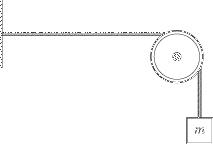Transverse Waves: Waves on a String
Imagine—or better yet, go grab some twine and set up—a length of string
stretched between two posts so that it is taut. Each point on the string is just
like a mass on a spring: its equilibrium position lies on the straight line
between the two posts, and if it is plucked away from its resting position, the
string will exert a force to restore its equilibrium position, causing periodic
oscillations. A string is more complicated than a simple mass on a spring,
however, since the oscillation of each point influences nearby points along the
string. Plucking a string at one end causes periodic vibrations that eventually
travel down the whole length of the string. Now imagine detaching one end of the
string from the pole and connecting it to a mass on a spring, which oscillates
up and down, as in the figure below. The oscillation at one end of the string
creates waves that propagate, or travel, down the length of the string. These
are called, appropriately, traveling waves. Don’t let this name confuse
you: the string itself only moves up and down, returning to its starting point
once per cycle. The wave travels, but the medium—the string, in this case—only
oscillates up and down.

The speed of a wave depends on the medium through which it is traveling. For a
stretched string, the wave speed depends on the force of tension,
FT,
exerted by the pole on the string, and on the mass density of the string,
µ:
µ = total mass / total length
The formula for the wave speed is:

Example

A string is tied to a pole at one end and 100 g mass at the other, and wound
over a pulley. The string’s mass is 100 g, and it is 2.5 m long. If the string
is plucked, at what speed do the waves travel along the string? How could you
make the waves travel faster? Assume the acceleration due to gravity is 10 m/s2.
Since the formula for the speed of a wave on a string is expressed in terms of
the mass density of the string, we’ll need to calculate the mass density before
we can calculate the wave speed.
µ = 0.1 kg / 2.5 m = 0.04 kg/m
The tension in the string is the force of gravity pulling down on the weight,
FT = mg = (0.1 kg)(10 m/s2) = 1N.
The equation for calculating the speed of a wave on a string is:

This equation suggests two ways to increase the speed of the waves: increase the
tension by hanging a heavier mass from the end of the string, or replace the
string with one that is less dense.
Longitudinal Waves: Sound
While waves on a string or in water are transverse, sound waves are
longitudinal. The term longitudinal means that the medium transmitting
the waves—air, in the case of sound waves—oscillates back and forth, parallel to
the direction in which the wave is moving. This back-and-forth motion stands in
contrast to the behavior of transverse waves, which oscillate up and down,
perpendicular to the direction in which the wave is moving.
Imagine a slinky. If you hold one end of the slinky in each of your outstretched
arms and then jerk one arm slightly toward the other, you will send a pulse
across the slinky toward the other arm. This pulse is transmitted by each coil
of the slinky oscillating back and forth parallel to the direction of the pulse.

When the string on a violin, the surface of a bell, or the paper cone in a
stereo speaker oscillates rapidly, it creates pulses of high air pressure, or
compressions, with low pressure spaces in between, called rarefactions. These
compressions and rarefactions are the equivalent of crests and troughs in
transverse waves: the distance between two compressions or two rarefactions is a
wavelength.
Pulses of high pressure propagate through the air much like the pulses of the
slinky illustrated above, and when they reach our ears we perceive them as
sound. Air acts as the medium for sound waves, just as string is the medium for
waves of displacement on a string. The figure below is an approximation of sound
waves in a flute—each dark area below indicates compression and represents
something in the order of 1024
air molecules.

Loudness, Frequency, Wavelength, and Wave Speed
Many of the concepts describing waves are related to more familiar terms
describing sound. For example, the square of the amplitude of a sound wave is
called its loudness, or volume. Loudness is usually measured in
decibels. The decibel is a peculiar unit measured on a logarithmic scale.
You won’t need to know how to calculate decibels, but it may be useful to know
what they are.
The frequency of a sound wave is often called its pitch. Humans can hear
sounds with frequencies as low as about 90
Hz and up to about 15,000Hz, but many
animals can hear sounds with much higher frequencies. The term wavelength
remains the same for sound waves. Just as in a stretched string, sound waves in
air travel at a certain speed. This speed is around
343m/s under normal circumstances, but it
varies with the temperature and pressure of the air. You don’t need to memorize
this number: if a question involving the speed of sound comes up on the
,
that quantity will be given to you.
Back
Next
div>
Next to display next topic in the chapter.
Practice Questions
Video Lessons and 10 Fully Explained Grand Tests
Large number of solved practice MCQ with explanations. Video Lessons and 10 Fully explained Grand/Full Tests.